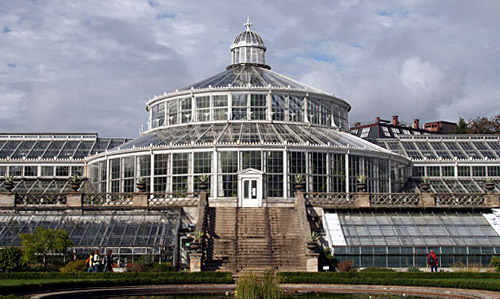The Greenhouses

The Palm House (greenhouses 1-5)
The large Palm House was built when the garden was founded in 1872-74, but was thoroughly renovated and supplied with modern technique in 1980-82. It is 94 m long and divided into five departments (house 1-5), each with its own climate. During the second half of the 19th century similar greenhouses were built in other European cities inspired by Crystal Palace, built for the world exhibition in London in 1852. A few of these impressive greenhouses still exist around Europe.
Greenhouse 1
Tropical water and marsh plants with water ferns, water trumpet (Cryptocoryne), papyrus, rice and the giant water lily (Victoria cruziana). Furthermore, species of mangrove trees with their characteristic roots.
Greenhouse 2
Includes plants from the warmer parts of the subtropical areas and a few tropical species. Many well-known useful plants such as date palm, coffee shrub, tea, cinnamon, passion flower, pomegranate and a number of citrus species, but also less known species like the tree tomato.
Greenhouse 3
Tropical rain forest climate. Many useful plants such as oil palm, kapok tree, banana, cocoa, papaya, mango, cardamom, ginger, etc. Also many other tropical plants such as various palms, screw pines, figs (Ficus), Philodendron and species of Maranta grow here besides an unusually large collection of old Cycas palms.
Greenhouse 4
Tropical plants mainly from areas with an annual dry period where the natural vegetation is savanna or forest steppe. Some useful plants like lignum vitae (guaiacum), guajava, calabash-tree, chewing gum tree, pepper plant and annual vinca (Cataranthus roseus) (used for medicine against cancer). Also many ferns are found here.
Greenhouse 5
Subtropical plants, especially from areas with a mediterranean climate such as the Mediterranean area, South Africa and south western South America. Here you will find the olive tree, stone pine, various oak species including the cork oak, myrtle, Acacia, Eucalyptus, strawberry tree (Arbutus), and rock-rose (Cistus). Also the gymnocarpous genera Podocarpus and Araucaria from the Southern Hemisphere grow here.
Low Houses (greenhouses 7-10)
Greenhouse 7
Tropical climate, especially with plants from the Pineapple family (Bromeliaceae): Pineapple, Aechmea, Vriesia, "Spanish moss" and other species of Tillandsia. Also epiphytic cacti (Rhipsalis) and a few other, especially endangered plants from the islands of Mauritius and Rodrigues in the Indian Ocean are grown here.
Greenhouse 8
Tropical climate. Dominated by many epiphytical Begonias, but also Hoya (wax flower), Sansevieria and Vanilla. A special niche, plants living with ants, is represented here with Myrmecodia and Dischidia.
Greenhouse 9
Tropical orchids, more than 500 species and varieties incl. a few hybrids. Most of them are epiphytes from the rain forest as the major part of tropical orchids, but also soil-inhabiting orchids like Paphiopedilum a.o. are represented.
Greenhouse 10
Cacti and other succulents from desert and steppe-areas, like cacti from America and spurges (Euphorbia) and "living stones" (species of Aizoaceae) from Africa. Furthermore, a large collection of plants from Madagascar and many special, so-called caudiciform plants, where the stem is short, bulbous or thickened and with a thick cortex layer. In all about 1,000 species.
Greenhouse 12
The rare and endangered plants are grown in a special greenhouse.
It is a characteristic feature that many of the endangered plants have developed on small, isolated islands and therefore have a very restricted distribution area and are not found elsewhere. These so-called endemic species are especially threatened by human activities such as the construction of roads, hotels and golf courses. Humans have also introduced animals which originally did not occur in the area. These animals breed successfully in the new areas and may very soon graze away the original vegetation, especially goats are very efficient. Also introduced plants may be a pest to the original vegetation. In many islands introduced plants have become troublesome weeds, ousting the original vegetation. Especially plants from oceanic islands are highly vulnerable. One third of all known endangered plants are island-endemics.
The greenhouse for the endangered species is 2 x 136 m².
In one of the houses plants from oceanic islands like Madagascar, the Mascarenes and the Galapagos Islands are grown. Originally, only 500 species of plants grew on the Galapagos Islands, of which about 180 were endemic. Since the discovery of the islands in 1535 a further 550 species have been introduced, of which a few are so invasive, that they threaten the original vegetation. One of them, Lantana which came to the islands as a garden plant, is also grown in Denmark, but our climate suppresses its dispersal.
In the other house there is an outstanding collection of orchids from Thailand. It was founded by the late Dr. Gunnar Seidenfaden who collected the plants while he was the Danish ambassador in Thailand. This collection is not open to the public, but only used for research (both houses are surveyed by videocameras!).
Greenhouses not open to the public
The other greenhouses (house 6, 11, 13-14, 15-27) are not open to the public. They contain e.g. plants from Madagascar, tropical and subtropical savanna plants, orchids from Thailand, plants from the Galapagos Islands and other especially endangered plants, Mediterranean plants and plants from Arctic and Alpine areas. Also, some of the houses are reserved for experiments and plant propagation.
